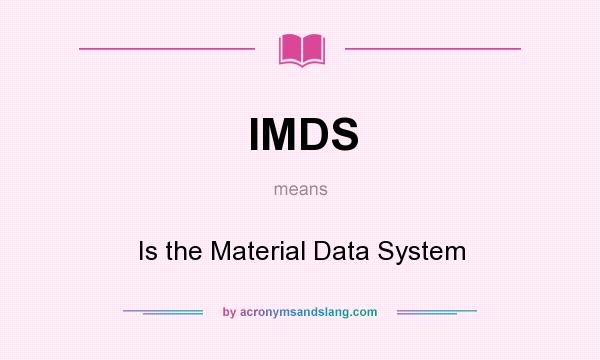If the Tier 1 supplier is not yet an IMDS user, a registration in the IMDS system must be done. This can be done directly online. Below are the links to IMDS system and its user-manual to register in IMDS. IMDS system Registration USER manual. IMDS DATA will save you time, money and headaches. We will take care of your International Material Database System (IMDS) requirements by creating and submitting Material Data Sheets (MDSs) for your parts. We have been doing this for automotive Tier 2.
The International Material Data System (IMDS) is a global data repository that contains information on materials used by the automotive industry. Several leading auto manufacturers use the IMDS to maintain data for various reporting requirements.
In the IMDS, all materials present in finished automobile manufacturing are collected, maintained, analysed and archived. IMDS facilitates meeting the obligations placed on automobile manufacturers, and thus on their suppliers, by national and international standards, laws and regulations.
Introduction[edit]
Introduced in June 2000, the IMDS was originally a collaboration of Audi, BMW, Daimler, EDS (now part of DXC Technology, the system administrator), Ford, Opel, Porsche, VW and Volvo.[1] Since inception the list of participating vehicle manufacturers and suppliers has grown greatly.[2]
Usage[edit]
Material Data System Imds
Because it is a computer-based system, IMDS highlights hazardous and controlled substances by comparing entered data with regulatory-originated lists of prohibited substances (GADSL,[3]REACH, ELV, etc...). Hence OEMs can trace hazardous substances back to the individual part and work with suppliers to reduce, control, or eliminate the hazard.

All substances must be declared in the material data sheet (MDS) of the IMDS to a resolution of 1 gram or better – not just declarable and prohibited substances (e.g. CrVI / Hg / Pb / Cd). Substances and materials of products must be known in detail so that it may be delivered by the OEMs to dismantler companies in order to achieve the goals of the ELV Directive.[4]
The basic workflow model of the system is for each supplier to submit data about the parts they sell to their direct customer. When each link in the supply chain submits data per this method, it mimics actual supply chain part flow, preserving customer-to-supplier relations. Data entry in IMDS is frequently a contractual requirement of PPAP which is one part of standard automotive quality systems.
Access and costs[edit]

The IMDS is easily accessed through the internet. The basic web browser version of the system is supported by the OEM sponsor's group and provided free of charge to suppliers in the automotive supply chain.[5]
There are several vendors that provide systems allowing compatible IMDS interaction with Product lifecycle management, download and upload, data format translation, and other reporting systems.[6][7]
Changes in 2013 and 2014[edit]
- 2013 – IMDS NT for Design Changes
- 2014 – IMDS 2020 for New Functions
References[edit]
- ^'IMDS Information Pages – Home'. Public.mdsystem.com. Retrieved 20 May 2015.
- ^'IMDS Information Pages – Community'. Public.mdsystem.com. Retrieved 20 May 2015.
- ^'Gadsl.Org'. Gadsl.Org. Retrieved 20 May 2015.
- ^'Classifying parts used by the automotive OEMs'. plasticstoday. Retrieved 7 July 2016.
- ^[1]Archived 10 January 2014 at the Wayback Machine
- ^IMDS Information Pages. 'IMDS Information Pages – IMDS Advanced Solutions'. Public.mdsystem.com. Retrieved 20 May 2015.
- ^[2]Archived 17 September 2013 at the Wayback Machine
International Material Data System Imds
External links[edit]
- End of Life Vehicles Directive 2000/53/EC